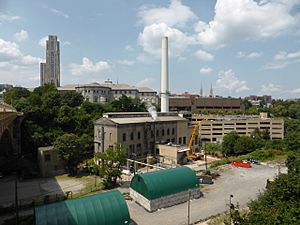Bellefield Boiler Plant facts for kids
The Bellefield Boiler Plant, often called "The Cloud Factory", is a special building in Pittsburgh, Pennsylvania. It got its nickname from a book called The Mysteries of Pittsburgh by Michael Chabon. This plant is located in an area known as Junction Hollow, right between the Carnegie Museums of Pittsburgh and Carnegie Mellon University.
This plant was built in 1907. Its main job was to create steam heat for the Carnegie Museums of Pittsburgh. It was designed in a style called Romanesque Revival. The original smoke stack was 150 feet tall, but it was removed in 2010. A newer, taller stack is now over 200 feet high.
The plant used to burn both coal and natural gas. However, it stopped burning coal on July 1, 2009, to be more environmentally friendly. In the 1930s, its heating system grew to also serve the University of Pittsburgh's Cathedral of Learning. Today, the Bellefield Boiler Plant provides heat to many important buildings in the Oakland area of Pittsburgh.
Many different organizations own the plant together. These include the University of Pittsburgh, University of Pittsburgh Medical Center, Carnegie Mellon University, the Carnegie Museums of Pittsburgh, the City of Pittsburgh, and the Pittsburgh Public Schools.
When the plant burned coal, it used a lot of it! It could go through a 70-ton train car of coal every day. These coal cars arrived by train on tracks that ran right next to the plant.
Why is it called "The Cloud Factory"?
The famous writer Michael Chabon used the name "Cloud Factory" for the Bellefield Boiler Plant in his 1988 novel. He might have heard locals use the name, or he might have made it up himself.
There's also a chance he got the idea from another famous writer, Henry David Thoreau. Thoreau wrote an essay in 1848 called Ktaadn and the Maine Woods. In this essay, Thoreau describes a mountain experience. He said the clouds around him made it feel like a "cloud factory." He wrote: "It was, in fact, a cloud factory—these were the cloud-works, and the wind turned them off done from the cool, bare rocks." This shows that the idea of a "cloud factory" has been around for a long time!





